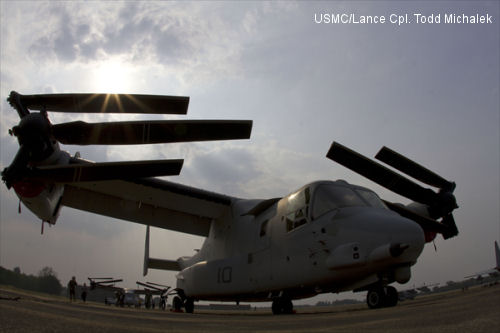
US Marine Corps, February 09, 2013 - NAKHON RATCHASIMA, Kingdom of Thailand By Lance Cpl. Todd Michalek - Four MV-22B Ospreys landed at Wing One Royal Thai Air Force Base, Nakhon Ratchasima, Kingdom of Thailand, Feb. 8 in preparation for exercise Cobra Gold 2013.
This marks the first time the aircraft has appeared in Thailand, which can be added to its list of accomplishments. The Ospreys are assigned to Marine Medium Tiltrotor Squadron 265, Marine Aircraft Group 36, 1st Marine Aircraft Wing, III Marine Expeditionary Force.
On the way to Thailand from Okinawa, the Ospreys received aerial refueling support from KC-130J Hercules aircraft. Traveling at speeds of up to 300 mph and an altitude of 25,000 feet, the flight demonstrated the enhanced capabilities the Ospreys bring to the U.S. and its partners in the region.
"This flight shows exactly what the Osprey is capable of in regards to response time for humanitarian assistance and disaster relief, or some other kind of mission,” said U.S. Marine Capt. Josh Carpenter, a pilot with VMM-265. “You don't have to put us on a boat. We can launch from Okinawa, refuel in the air with C-130s, and get to where help is needed.”
Cobra Gold provides an ideal opportunity for VMM-265 to further showcase the MV-22’s significantly advanced capabilities, which enhances the U.S. military’s ability to perform a wide range of missions in the Asia-Pacific region.
"The Osprey is a pretty intelligent aircraft. It will let you know what’s going on before you even think about it,” said U.S. Marine Cpl. Wesley Motschenbacher, a crew chief with the squadron. “In my opinion, it's one of the safest aircraft the Marine Corps is employing. I've been flying in the Osprey for about three years now, and I feel very comfortable in it."
The aircraft’s role in CG 13 is primarily certifying new flight routes and familiarization of terrain to meet training objectives.
"We conduct low altitude training, which can be used against an enemy threat,” said Motschenbacher. “We're in Thailand trying to certify some routes for the MV-22 because we are new to the Pacific theater, and we need to have those routes laid out."
Terrain and flight-path association is a priority, added Motschenbacher, because should they have to fly a real-world mission in Thailand, they know what to expect of the terrain and the time it takes to execute the mission.
“Low altitude routes are very heavily involved in our training plan and are included in the training and readiness plan we use,” said Carpenter. “It's very important that we get the pilots proficient in flying at 500 feet and below, avoiding terrain and (simulated) high-threat areas."
As the Osprey is increasingly integrated into theater security cooperation engagements throughout the Pacific, its proven performance is sure to leave a legacy of addressing the needs of the U.S. as well as the humanitarian needs of the Asia-Pacific region.
This marks the first time the aircraft has appeared in Thailand, which can be added to its list of accomplishments. The Ospreys are assigned to Marine Medium Tiltrotor Squadron 265, Marine Aircraft Group 36, 1st Marine Aircraft Wing, III Marine Expeditionary Force.
On the way to Thailand from Okinawa, the Ospreys received aerial refueling support from KC-130J Hercules aircraft. Traveling at speeds of up to 300 mph and an altitude of 25,000 feet, the flight demonstrated the enhanced capabilities the Ospreys bring to the U.S. and its partners in the region.
"This flight shows exactly what the Osprey is capable of in regards to response time for humanitarian assistance and disaster relief, or some other kind of mission,” said U.S. Marine Capt. Josh Carpenter, a pilot with VMM-265. “You don't have to put us on a boat. We can launch from Okinawa, refuel in the air with C-130s, and get to where help is needed.”
Cobra Gold provides an ideal opportunity for VMM-265 to further showcase the MV-22’s significantly advanced capabilities, which enhances the U.S. military’s ability to perform a wide range of missions in the Asia-Pacific region.
"The Osprey is a pretty intelligent aircraft. It will let you know what’s going on before you even think about it,” said U.S. Marine Cpl. Wesley Motschenbacher, a crew chief with the squadron. “In my opinion, it's one of the safest aircraft the Marine Corps is employing. I've been flying in the Osprey for about three years now, and I feel very comfortable in it."
The aircraft’s role in CG 13 is primarily certifying new flight routes and familiarization of terrain to meet training objectives.
"We conduct low altitude training, which can be used against an enemy threat,” said Motschenbacher. “We're in Thailand trying to certify some routes for the MV-22 because we are new to the Pacific theater, and we need to have those routes laid out."
Terrain and flight-path association is a priority, added Motschenbacher, because should they have to fly a real-world mission in Thailand, they know what to expect of the terrain and the time it takes to execute the mission.
“Low altitude routes are very heavily involved in our training plan and are included in the training and readiness plan we use,” said Carpenter. “It's very important that we get the pilots proficient in flying at 500 feet and below, avoiding terrain and (simulated) high-threat areas."
As the Osprey is increasingly integrated into theater security cooperation engagements throughout the Pacific, its proven performance is sure to leave a legacy of addressing the needs of the U.S. as well as the humanitarian needs of the Asia-Pacific region.
See also |
VMM-265




